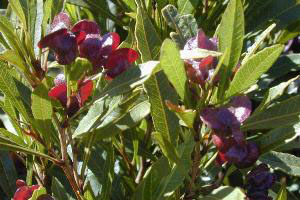In Hawaii, the colorful fruits of Florida hopbush are used to make leis for the hair.
Photo Credit: © Forest and Kim Starr, U.S. Geological Survey, Bugwood.org.
Dodonaea viscosa
Common Name: Florida hopbush
Other Common Names: hopbush, hopseed bush
Plant Functional Group: Evergreen broadleaf
Class > Order > Family: Magnoliopsida > Sapindales > Sapindaceae
